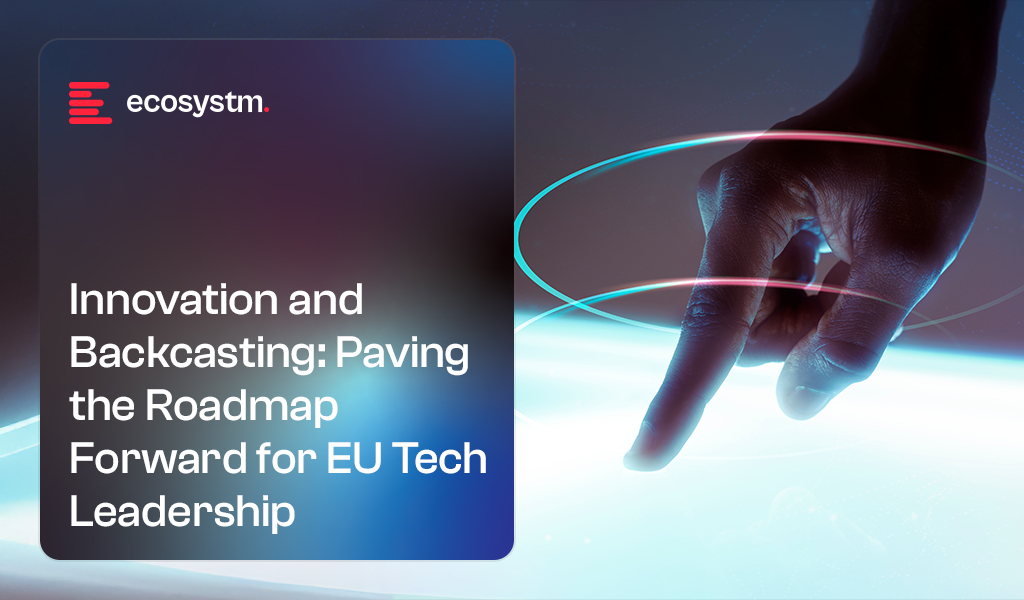Earlier this week, during a virtual networking event, a group of tech entrepreneurs asked for an explanation of backcasting. I described it as not only a way to guide a firm and its technology toward a desired future, but also as a method for identifying and filling gaps along the way to maximise opportunity.
At this moment, the European Union (EU) stands at a pivotal moment with its renewed emphasis on fostering innovation and achieving digital independence. As geopolitical economic dynamics continue to evolve, a strategic approach is vital for EU tech vendors; not just to navigate uncertainty but to actively seize opportunities along the way for further advancement.
The reliance on global (read: US) tech players as platforms is seen as continuing to impact European innovation. Two recent announcements underpin this. Google warned EU antitrust regulators and its critics that the Digital Markets Act (DMA) is hampering innovation to the detriment of European users and businesses. However, Google is under pressure to address requested charges under the EU’s Digital Markets Act in building their case on compliance. And the EU set out plans to pool funding and expertise in quantum to build a competitive European ecosystem in this key technology area. This funding push goes into the private sector for assistance to attract private funding to help the EU take the lead in quantum technology by 2030. EU tech chief Henna Virkkunen said on 1 July, as she announced the EU Quantum Strategy, that the EU is working to cut its reliance in the sector on the US and China.
Can data save the day? And can filling those holes while backcasting the business direction create independence from reliance on big tech?
Data as the Fifth Freedom and the Drive for Tech Sovereignty
The EU’s single market is well-known for its four freedoms: the free movement of goods, services, capital, and labour. However, a 2024 report by former Italian Prime Minister Enrico Letta proposes a crucial “fifth freedom” – encompassing research, innovation, data, and knowledge. This recognises data’s role as a prime production factor in modern economies and a powerful catalyst for innovation.
The EU has acknowledged that over-reliance on global tech giants, often headquartered outside Europe, can hinder its strategic autonomy and economic security. This realisation has fuelled a push for “tech sovereignty”, an initiative aimed at building a robust European tech sector capable of global competition and reducing dependence on non-EU entities. Measures such as the European Commission’s AI strategy, the Digital Services Act (DSA), and the Digital Markets Act (DMA) are intended to strengthen the EU’s technological competitiveness and independence.
This drive goes beyond regulation. It’s about enabling the creation of new technologies and investing in strong European infrastructure across critical domains such as AI, quantum computing, and biotech. There’s also growing demand for European-based digital services, driven by privacy concerns and the concentration of power among non-EU tech firms.
A Strategic Opportunity: The US Tax Code Adjustment
Adding to this strategic window of opportunity is a fiscal development in the US tax code. Section 174 of the US tax code governs the treatment of Research and Development (R&D) expenditures. A significant change to this section came with the Tax Cuts and Jobs Act (TCJA) of 2017. For tax years beginning after December 31, 2021, companies can no longer immediately deduct 100% of their R&D expenses in the year they are incurred. For R&D conducted within the country, specified research or experimental expenditures (SREs) must now be amortised over a five-year period. All costs associated with software development are also explicitly categorised as Section 174 expenses and subject to these amortisation rules.
According to tax consulting firm KBKG, these changes have “significantly increased the tax burden on companies investing in innovation, potentially stifling economic growth and reducing the United States’ competitiveness on the global stage.” While bipartisan efforts are underway in the US to repeal or retroactively amend this change, the political landscape remains volatile, and any resolution may come too late for many affected companies.
This tax shift has been cited by many in the tech industry as a driver behind recent layoffs. It also presents a unique window of opportunity for EU tech firms to increase their R&D investments and gain a competitive edge while their US counterparts grapple with rising tax burdens on innovation.
Backcasting: Charting a Course for EU Tech Leadership
In an age characterised by unpredictability, policy shifts, trade disruptions, and macroeconomic instability, traditional forecasting often proves inadequate. This is where backcasting becomes an invaluable tool for EU tech vendors. Unlike forecasting, which projects current trends forward, backcasting starts with a clear, desired future state and works backward to identify the steps, milestones, and investments required to reach that vision, while helping to identify and fill critical gaps along the way.
This strategic approach offers several key advantages for European tech firms:
- Strategic Alignment. Backcasting directly links today’s investments to tomorrow’s objectives, ensuring that current initiatives contribute purposefully to long-term ambitions.
- Justifying Investment. By clearly outlining the journey from the present to the future, backcasting helps organisations articulate and justify long-term investments in innovation and R&D, crucial for securing budgets in a tightly scrutinised financial environment.
- Adaptability and Agility. While grounded in a future vision, backcasting is an iterative process that allows course correction as the global landscape evolves, enabling teams to stay agile yet focused on their end goals.
- Regional Resilience. In a world of increasingly fragmented global interconnectivity, using a backcasting framework to invest in local innovation, talent, and infrastructure strengthens economic independence and supports sustainable growth for the EU tech sector.
By adopting backcasting, EU tech vendors can turn the challenges of an uncertain future into a deliberate, confident path toward sustained growth and competitiveness. It marks a fundamental shift in mindset, empowering organisations not just to react to change, but to proactively shape the future they want to lead.
Partner with Ecosystm to Define Your Backcasting Journey
Envisioning the next decade – and systematically working backward from that future requires both imagination and rigour. My colleague Tim Sheedy and I at Ecosystm can help your organisation shape a clear, actionable backcasting strategy that connects long-term vision to immediate priorities.
We offer a range of ways to support your journey from workshops and internal training to client-facing sessions, webinars, and co-created content. Whether you’re looking to build internal capability or align stakeholders around future goals, we can tailor our approach to your needs.
If backcasting could support your growth or budget planning, we’d love to connect, either in person or via a quick call. And we welcome your feedback at any time. Feel free to reach out to me or Tim directly.

Typically, business leaders rely on forecasts to secure budgets for achieving their goals and objectives. Forecasts take historical trends and project them forward, with added assumptions about what may or may not change in the market or operating environment.
But in today’s volatile economic and political climate, traditional forecasting is increasingly unreliable.
The threat of tariffs, actual tariffs, ongoing and emerging conflicts, political transitions and rising authoritarianism, along with the uncertain impact of AI on employment and productivity, are all undermining not just business and consumer confidence, but also supply chains and manufacturing capacity.
Look at the PC market in Asia Pacific. Shipments have traditionally been relatively straightforward to forecast; but in 2025, projections have swung from a 10% decline to 12% growth, and everything in between! These forecasts continue to shift month by month as market conditions evolve. The same applies to tech and non-tech products and services across many industries. Forecasts are no longer reliable or trustworthy.
So, if we cannot trust forecasts, what can we do to secure budget for our short-, medium- and longer-term initiatives? For many leaders, the answer is “Backcasting”.
When Forecasts Break Down, Backcasting Steps Up
Put simply, backcasting is creating a future vision, and building a plan to make that vision a reality.
For example, imagine you are the Asia Pacific Managing Director of a US-based software company aiming to move from the fifth to the second-largest provider in the region by 2030. To reach this goal, you’ll need to build specific capabilities such as adding distributors; expanding implementation and systems integration partners across ASEAN and India (which means strengthening your partner management team); increasing sales and account managers in tier 2 cities; and developing localised product versions and language support. You might also need to choose a different cloud provider to access certain markets like China and adapt your software to meet local regulations.
Backcasting helps you plan all these steps by starting with your 2030 goal and working backwards to create a clear roadmap to get there.
The benefit of backcasting over forecasting is that it gives your organisation defendable goals, targets and initiatives. It moves the thinking beyond the traditional quarterly targets to a longer-term vision. When global leaders ask you to cut budgets, it provides them with clear insight into how those cuts will affect the organisation’s success in Asia Pacific over the medium to long term. It also helps to understand which resources will help you achieve the longer-term goals and which will not.
Ultimately, backcasting is a better way of helping you defend your budgets from the tactical cuts and short-sighted strategies and sharpens your capability to deliver results in the longer term.
Want to Know More?
You can access a detailed report on backcasting: what it is, how it differs from traditional forecasting, and how it can be applied within your organisation. The report includes examples of companies using backcasting to shape strategic initiatives and support innovation, as well as a scenario outlining how an Asia Pacific tech vendor might use the approach to meet growing regional demands.
We have also helped clients start their backcasting journeys through targeted workshops, internal presentations, training programs and helping them set the backcasting strategy and processes in place. These services can support organisations at a strategic level, by aligning long-term plans with overarching goals; or at a team level, by helping functions like sales and marketing meet specific performance expectations.
We welcome your feedback – feel free to contact me or Alea Fairchild. If backcasting could support your organisation’s growth or budget planning, we’d be happy to connect via call or in person to discuss specific needs.
Here’s how we can help:
- Workshops. In-person or virtual workshops designed to build backcasting capabilities, such as setting long-term goals, creating roadmaps, and shifting focus from short-term tactics to strategic outcomes.
- Training (Internal Presentations & Webinars). Sessions to introduce teams to backcasting, explaining what it is, how it can be used, and why it supports more effective mid- to long-term planning.
- Client-Facing Presentations. Presentations tailored for clients and customers to show how backcasting can support their planning and investment decisions, potentially strengthening alignment with available solutions.
- Podcasts & Videos. Co-created audio or video content with leadership to explore how backcasting fits into current workflows, where the value lies, and how teams can tailor their efforts to organisational priorities.




